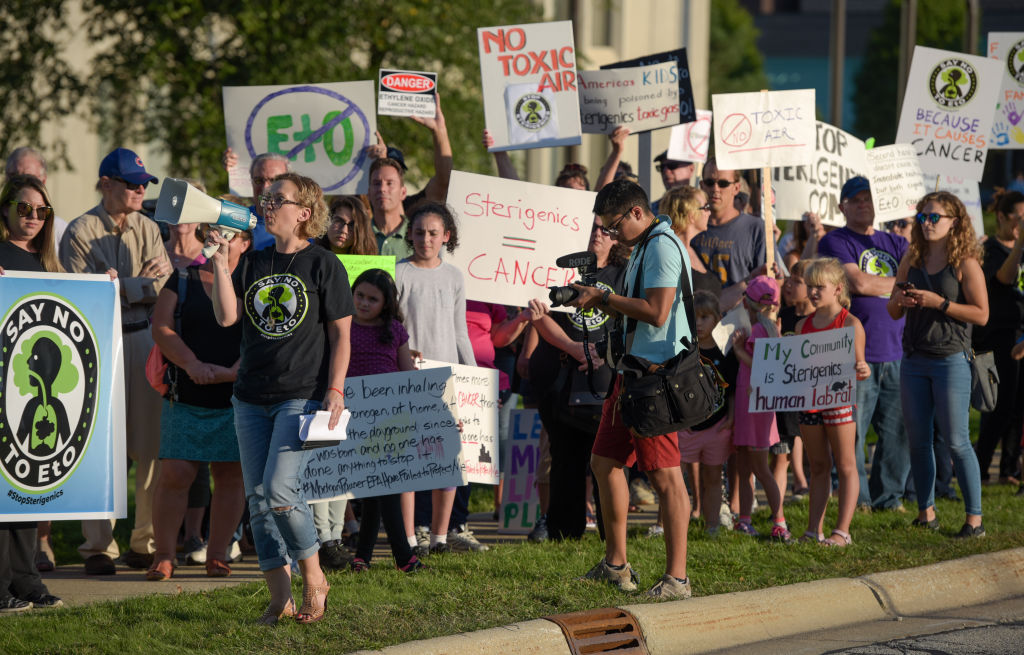The chemical compound ethylene oxide is manufactured and used in hundreds of facilities across the United States. Linked to lymphoma, leukemia, and breast cancer, the carcinogen is used to sterilize about half of all medical devices in the country. Over the last few years, as evidence of its toxicity has become more clear, regulators have attempted to step up enforcement against ethylene oxide emitters. Still, penalties for allowing workers — who have some of the highest exposure risks — to breathe dangerous levels of the chemical have been few and far between.
That may be changing. In the Southern California city of Carson, Parter Medical Products uses ethylene oxide in the process of manufacturing single-use petri dishes and vials. Last week, the California Division of Occupational Safety and Health, or Cal/OSHA, fined the facility more than $800,000 for exposing its employees to dangerous levels of the toxic substance.
Between 2019 and 2023, the agency found that employees were repeatedly exposed to as much as five times the state’s standard for acceptable exposure. For endangering employees’ health, the agency issued 18 citations, which included what it calls “willful-serious” cases in which the agency found that Parter knowingly exposed employees to the toxic chemical.
“Our inspection showed this was not an isolated incident of chemical overexposure to workers,” Cal/OSHA chief Jeff Killip said in a press release. “The employer failed to take action to protect employees even after it knew that some of them were exposed to dangerous levels of ethylene oxide.”
The enforcement action comes as federal regulation of ethylene oxide is evolving. In 2016, the Environmental Protection Agency, or EPA, found that ethylene oxide was 30 times more toxic for adults than previously thought. The agency set a new upper limit for lifetime cancer risk at 11 parts per trillion, or ppt. That means if 10,000 people are exposed to ethylene oxide at an 11-ppt concentration for 70 years, one of them will develop cancer. That such a low concentration of ethylene oxide can result in cancer is a sign of its extraordinary toxicity.
“This is a highly toxic compound,” said Jane Williams, executive director of California Communities Against Toxics. “Besides dioxin, it’s now the most toxic compound that we regulate in our regulatory infrastructures, and you have workers that are at the highest exposures.”
The EPA and other federal and state agencies that oversee air quality and worker safety have slowly moved to tighten exposure standards and emission rules. In California, the legal threshold at which regulatory agencies intervene to protect workers’ health is 1 part per million, or ppm, over 8 hours of exposure. At Parter, Cal/OSHA found one employee was exposed to levels on average five times larger than that limit.
Parter first ran into trouble last year. The South Coast Air Quality Management District, a local regulatory agency, collected air samples within the facility and conducted air monitoring outside the facility in July. When it found ethylene oxide levels that were higher than permitted, it issued Parter a notice of violation for releasing air contaminants that endanger health and safety of the public and also referred the case to Cal/OSHA. In response, Parter shut down operations in August and installed air pollution control equipment to better capture ethylene oxide emissions.
However, after the facility reopened, Cal/OSHA reinspected it in December and found that workers were still being exposed to unacceptably high levels of ethylene oxide. As a result, six of the 18 citations Cal/OSHA issued are “willful-serious,” a category reserved for situations when the employer was “aware that an unsafe or hazardous condition existed and made no reasonable effort to eliminate the condition.”
Parter representatives did not respond to Grist’s requests for comment.
Cal/OSHA’s fine may be a sign of more significant enforcement action forthcoming against other companies in the state. There are 14 other commercial sterilizer facilities in California. In the cities of Vernon and Ontario, two facilities owned by Sterigenics were similarly investigated last year by the South Coast air district and found to be in violation of air quality rules.
Cal/OSHA’s findings raise a number of questions about what the Parter facility’s emissions mean not just for its workers, but also for those who live nearby. The plant is located just 700 feet from a residential community and about 2,000 feet from an elementary school. The local air district has set up monitors in the community and recent readings show that levels are below the state’s standard for residential cancer risk of 260 ppt — but they are three to 20 times higher than the level the EPA considers safe.
“You have parts-per-million levels inside [the facility],” said Williams. “There’s no way you can have parts-per-million levels inside that building and protect people at the fenceline.”
The South Coast Air Quality Management District did not respond to Grist’s questions in time for publication.
The local air quality district is working on new rules to tighten standards for ethylene oxide emissions from sterilizer facilities like Parter’s. The EPA is also working on a series of rules addressing the chemical’s emissions from the manufacturing sector as well as sterilizer facilities. On Friday, the agency is expected to announce a draft rule requiring additional pollution controls for facilities that manufacture ethylene oxide. Separately, the agency is also working on rules to reduce emissions from sterilizer facilities. However, in 2014 and 2022 the agency missed previous deadlines to propose new rules that better protect communities from ethylene oxide exposure. The environmental group Earthjustice sued the agency late last year over the delay.
Editor’s note: Earthjustice is an advertiser with Grist. Advertisers have no role in Grist’s editorial decisions.
Lylla Younes contributed reporting to this story.




